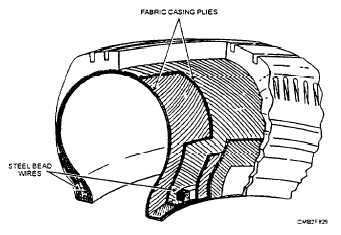wheel-bearing construction for both rear-wheel and front-wheel drives.
TIRE CONSTRUCTION
Most modern passenger vehicles and light trucks use tubeless tires that do NOT have a separate inner tube. The tire and wheel form an airtight unit. Many commercial and construction vehicles use inner tubes which are a soft. thin. leakproof rubber liner that fit inside the tire and wheel assemblies. However. in the last few years tubeless tires have been introduced to commercial and construction vehicles. reducing the need for tube type tires. Tires perform the following two basic functions:
They must act as a soft CUSHION between the road and the metal wheel.
They must provide adequate TRACTION (friction) with the road surface.
Tires must transmit driving. braking. and cornering forces to the road in all types of weather. At the same time, they should resist puncture and wear. Although there are several tire designs. the six major parts of a tire are as follows:
TIRE BEADS (two steel rings encased in rubber that holds the tire sidewalls against the wheel rim).
BODY PLIES (rubberized fabric and cords wrapped around beads. forming the carcass or body of the tire).
TREAD (outer surface of the tire that contacts the road surface).
SIDEWALL (outer surface of the tire extending bead to tread; it contains tire information).
BELTS (used to stiffen the tread and strengthen the plies; they lie between the tread and the inner plies).
LINER (a thin layer of rubber bonded to the inside of the plies: it provides a leakproof membrane for tubeless tires).
There are many construction and design variations in tires. A different number of plies may be used and ran at different angles. Also, many different materials may be used. The three types of tires, found on late model vehicles, are bias-ply, belted bias. and radial.
Bias-Ply Tire
A bias-ply tire is one of the oldest designs, and it does NOT use belts. The position of the cords in a bias-ply tire allows the body of the tire to flex easily. This design improves the cushioning action, which provides a smooth ride on rough roads.
A bias-ply tire (fig. 8-29) has the plies running at an angle from bead to bead. The cord angle is also reversed from ply to ply, forming a crisscross pattern. The tread is bonded directly to the top ply.
A major disadvantage of a bias-ply tire is that the weakness of the plies and tread reduce traction at high speeds and increase rolling resistance.
Belted Bias Tire
A belted bias tire provides a smooth ride, good traction, and offers some reduction in rolling resistance over a bias-ply tire. The belted bias tire is a bias-ply tire with stabilizer belts added to increase tread stiffness. The belts and plies run at different angles. The belts do NOT run around to the sidewalls but lie only under the tread area. Two stabilizer belts and two or more plies are used to increase tire performance.
Radial Ply Tire
The radial ply tire (fig. 8-30) has very flexible sidewall, but a stiff tread. This design provides for a very stable footprint (shape and amount of tread touching the road surface) which improves safety, cornering, braking, and wear. The radial ply tire has plies running straight across from bead to bead with stabilizer belts directly beneath the tread. The belts can be made of steel, flexten, fiber glass, or other materials.

Figures 8-29. - Bias-ply tire construction.
Continue Reading